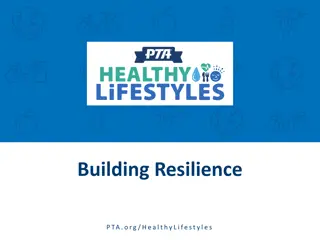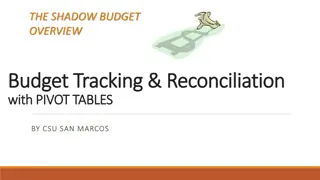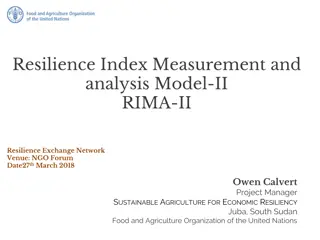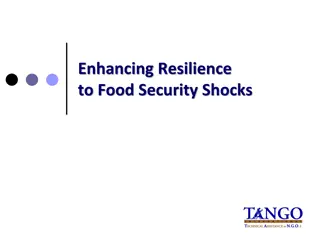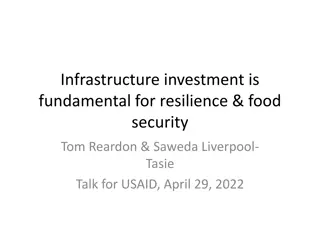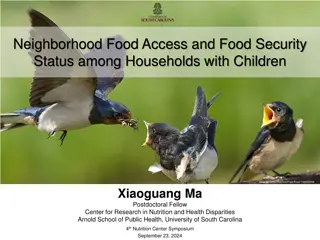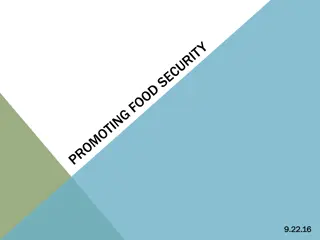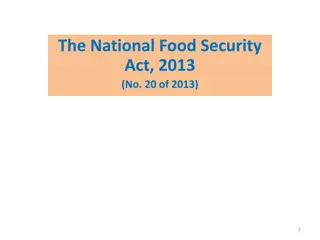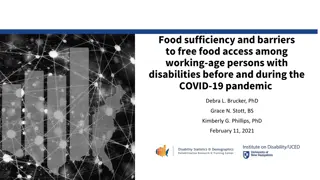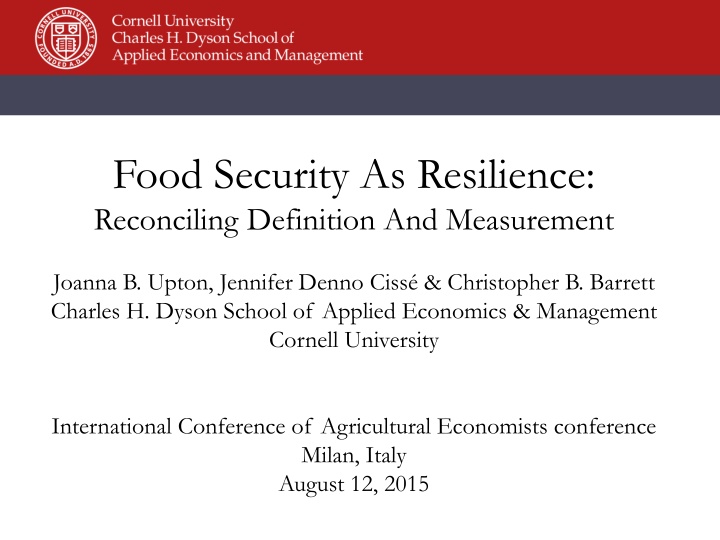
Food Security as Resilience: Reconciling Definition and Measurement
The article delves into the complex task of measuring food security by exploring the internationally agreed definition and its implications on measurement axioms. Challenges, motivations, and potential solutions are discussed, emphasizing the importance of aligning measurement with the core principles of food security. The concept of development resilience is introduced as a potential pathway to enhance measurement approaches.
Download Presentation

Please find below an Image/Link to download the presentation.
The content on the website is provided AS IS for your information and personal use only. It may not be sold, licensed, or shared on other websites without obtaining consent from the author. If you encounter any issues during the download, it is possible that the publisher has removed the file from their server.
You are allowed to download the files provided on this website for personal or commercial use, subject to the condition that they are used lawfully. All files are the property of their respective owners.
The content on the website is provided AS IS for your information and personal use only. It may not be sold, licensed, or shared on other websites without obtaining consent from the author.
E N D
Presentation Transcript
Food Security As Resilience: Reconciling Definition And Measurement Joanna B. Upton, Jennifer Denno Ciss & Christopher B. Barrett Charles H. Dyson School of Applied Economics & Management Cornell University International Conference of Agricultural Economists conference Milan, Italy August 12, 2015
Motivation Measurement matters! But must be founded on agreed definition of subject The internationally agreed (1996) definition of food security: Food security exists when all people at all times have physical, social, and economic access to sufficient, safe and nutritious food that meet their dietary needs and food preferences for an active and healthy life. Challenging to measure because intrinsically unobservable Nonetheless, definition implies some axioms of measures
Motivation Decades of grappling with measurement Different metrics have different goals (to meet different needs) Metrics each reflect one or more observable dimension of food security Sometimes try to combine dimensions using indices but that introduces many well-known problems No existing measure well captures food insecurity per internationally agreed definition and derivative axioms
Punch line The emergent concept of development resilience (Barrett & Constas PNAS 2014) may offer a way forward (in time, not immediately) . Barrett and Constas (PNAS 2014) offer a theoretical foundation for development resilience that we show can fit the 4 axioms implied by 1996 definition of food security. Econometric implementation of BC is now feasible with adequate individual/household panel data We illustrate empirically how this can prove useful This is a suggestive exercise only, meant to prompt continued pursuit of better measurement.
Axioms of measurement The 1996 FAO definition of FS implies 4 core measurement axioms: all people the scale axiom (address both individuals and groups at various scales of aggregation) at all times the time axiom (assess stability, given both predictable and unpredictable variation) physical, social, and economic access the accessaxiom (must control for poverty, institutions, infrastructure) an active and healthy life the outcomes axiom (nutrition/ health outcome indicators are the ultimate targets) Claim: Measures should adhere, as better as possible, to these axioms.
Data challenges Measures necessarily depend on data. And data quality issues abound. Shortcomings in national-level data Often must rely on national governments Disagreement on what to collect, and/or how Resource and capacity constraints make for unreliable quality also in household-level data Analytical challenges (sampling and survey design) Reliability (proxy reporting, recall, accounting for income ) Nutrient composition tables not universal Limited comparability between data sets Attrition Etc
Data challenges All levels of data collection face challenges of: Consistency over time Funding streams usually have short-term time scales Methods & priorities change with actors and institutions Cost Especially large scale, repeated collection Challenges typically greatest where need is most acute But, some new opportunities are emerging New data sources and technologies (e.g., ICT, RS)
Existing metrics We can rate metrics for how they perform in addressing the 4 axioms that follow from the agreed 1996 FS definition 8 For the most part, the choice of metric involves trade-offs 1 One-off, aggreg.availability 2 Annual, aggreg. availability 3 One-off, hh-level (e.g.,DD) 4 High freq, aggreg. avail./access 5 Annual, aggreg. composite 6 Annual, hh-level poverty 7 Annual, hh-level DD 8 High freq,indiv/hh health outcomes 7 3 6 5 2 1 4 Larger size indicates better representation of the access axiom Darker color indicates better reflection of the outcomes axiom
Existing metrics Other criteria besides axiom satisfaction are also important: Cost; difficulty (analytical and logistical); comparability between countries and other groups And, different metrics address different needs: For example, a health metric may capture the end outcome, but without other metrics we don t understand mechanisms in order to design/evaluate appropriate interventions Food security is ultimately about individuals, but national- and multinational-level information is needed for policy So tradeoffs abound among current food security metrics
Adapting development resilience As applied to humans, development resilience is both a capacity and a state (Barrett and Constas PNAS 2014): Capacity: The likelihood over time of a person, household or other aggregate unit enjoying adequate well-being in the face of various stressors and in the wake of myriad shocks. State: If and only if that likelihood is and remains high, then the unit is resilient. One can adapt this for food security measurement when using health/nutrition indicators of well-being
A moments-based approach Describe stochastic well-being dynamics (in reduced form) with moment functions: mk(Wt+s | Wt, Xt, t) where mk represents the kth moment (e.g., mean (k=1), variance (k=2), etc.) Wt is well-being at time t Xt is vector of conditioning variables at time t t is an exogenous disturbance (scalar or vector) at time t
Adapting resilience for food security We can adapt the concept of development resilience for food security by using an indicator for an active and healthy life . This measure can address all 4 food security axioms: Satisfies the time and scale axioms (short and long term dynamics; estimate for individuals/ households but aggregable to larger groups) The access outcome can be addressed by conditioning the moments on any host of economic, physical, or social characteristics We take as outcomes either proxy or direct indicators of health/nutrition status
Adapting resilience for food security Key limitation remains data Some possibilities, and proposals for easing this constraint (see Headey & Barrett PNAS in press on sentinel sites) Data on shocks not previously systematically considered but increasingly possible (satellite imagery, etc.) We have illustrative applications of the metric to evaluate food insecurity among rural households in northern Kenya
An empirical example Northern Kenya (Marsabit County) 924 households, tracked annually for 5 years (2009-2013) Data collected by ILRI and partners to assess the impacts of Index Based Livestock Insurance (IBLI) Period encompasses a massive drought (2011) Data include several well-being outcomes: hh livestock holdings, expenditures, food consumption, individual child anthropometry, etc. and can control for exogenous environmental conditions (esp. NDVI of rangelands)
An empirical example Outcome variables: Household dietary diversity score (HDDS) based on 7-day recall and child mid-upper arm circumference (MUAC) these satisfy the outcomes axiom. Conditioning variables: a host of access-related variables at community, agro-ecological and household level satisfy the access axiom Household and individual panel data satisfy the time and scale axioms
Resilience categorization Follow procedure developed by Ciss and Barrett (2015) Implementation demands (at least) two normative judgements: Level Minimum acceptable standard of adequate well-being , for an individual or household. For this example we use: Individual child MUAC -1 SD by WHO SDs HDDS mean of upper 1/3 of sample (per FANTA III) Probability Minimum acceptable likelihood of meeting level: We set ? 0.25 but then test alternative levels Note: Like poverty lines, these are intrinsically arbitrary cut-offs
Resilience categorization Step 1: Estimate the conditional mean MUAC and HDDS equations, conditioned on: Lagged well-being (MUAC/HDDS) in cubic polynomial to allow for nonlinear path dynamics A range of access indicators wealth(TLUs), location, demographics, etc. OLS w/robust standard errors. Step 2: Capture residuals and estimate conditional variance similarly. Assume normality for simplicity in illustration, so 1 and 2 suffice. Step 3: Use predicted conditional mean and conditional variance to estimate conditional cdf for each child (MUAC) or HH (HDDS), categorize as resilient if ?(? W) 0.25.
Resilience aggregation We can, by construction, aggregate the resilience measure for different groups, just like FGT for poverty: ? 0 ?????,0,2 ?;? = 7.9,? = .25 1 1 ? ?? ?=1 ? ?? ?=1 = 0.371 ? ? 0 ?????,0,2 ?;? = 1 ?.?.,? = .25 1 1 = 0.824, ? Different measures yield strikingly different aggregate results: just before 2011 drought struck, widespread resilience with moderate MUAC threshold, limited resilience with strict HDDS threshold.
Resilience aggregation Captures time-varying, group-specific estimates of food security: Key implication: Can identify targeting characteristics and project out of sample to generate predictions for targeting purposes.
Policy advantages By varying ? can choose to minimize errors of exclusion, inclusion, or their sum, depending on operational priorities. Estimates of Targeting Accuracy - HDDS Correctly Not Targeted Correctly Targeted Sum of Errors P TI Error TII Error 0.15 0.266 0.503 0.088 0.143 0.231 0.20 0.198 0.566 0.156 0.080 0.236 0.25 0.122 0.609 0.231 0.037 0.268 0.30 0.056 0.644 0.298 0.002 0.300 0.209 0.536 0.145 0.110 0.255 Standard Relative to current practice of using most recent observation (implicitly, random walk assumption), can outperform in forecasting.
Summary and next steps Food security measurement is important. The world is making slow but steady progress in improving these measures. But need to maintain fidelity to agreed definitions and the axioms they imply. An adaptation of emergent development resilience measures shows promise as a next-generation food security measure. Its implementability is sharply limited by data availability. Opportunity to develop robust, axiomatic measures of food security is considerable So is the opportunity to improve food security programming through the use of improved measures for diagnosis, inference, prediction and targeting.



